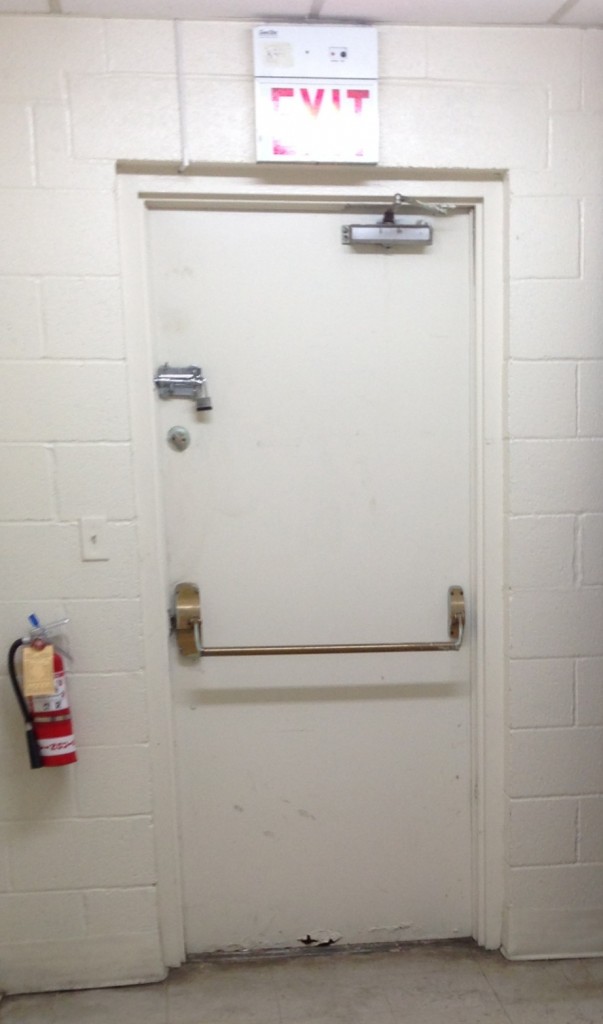 Would you be shocked if one of your managers allowed your stock room to look like this? Not only is this unsightly and a great way to lose inventory, but it’s also a breaks several important code violations.
Would you be shocked if one of your managers allowed your stock room to look like this? Not only is this unsightly and a great way to lose inventory, but it’s also a breaks several important code violations.
For example, per NFPA life safety code, all marked exits must be clear and accessible.
Facility Directors and Loss Prevention Managers are often surprised when we report some of the many code violations we see in the field. Unfortunately, we see code violations like this –which can easily be corrected– far too often.
Code Compliance for Doors and Locks
There are many facets to ADA code compliance when it comes to doors and locks.
Did you know that it is against code to have a “vision light” (a window in the door) higher than 43” above the finished floor? People in wheel chairs need to be able to see outside just like someone standing.
The same holds true for NFPA code compliance.
From fire-rated labels to delayed egress hardware, there’s a ton to know in order to ensure that you don’t get nailed with code violations.
To make things a bit easier, we have compiled a list of the top five code violations we see in the field and what you should do to correct them.
Top Five Code Violations
1. Blocked/Locked Exits
NFPA code requires all exits to be clear and accessible.
While we don’t often see cases as bad as the one pictured above, it is very common for stock room doors to be blocked with boxes, stock carts, and trash. This is an easy fix – mandate that your managers keep exits clear and unobstructed.
 2. Locked Exits
2. Locked Exits
In addition to being clearly accessible, all exits must remain unlocked during hours of operation.
This is one of the most common code violations we come across. We regularly see exit doors that have auxiliary locking hardware on them, such as dead bolts or slide bolts, in addition to an exit device. This is a huge no-no.
This auxiliary locking hardware is often installed in an attempt to increase the security level of the door. Resolving this could be as simple as installing an inexpensive hinge-side deadbolt. There are many different code compliant ways to increase the security of your doors.
3. Knob Lock Sets
ADA code 404.2.7 requires that all “door hardware that can be operated with a closed fist or a loose grip that accommodates the greatest range of users.” Translated– this means that you cannot use a knob lock set since they require both tight grasping and twisting of the wrist.
Instead of using knob lock sets, install lever sets on all doors.
4. Improper Use of Delayed Egress
Many Loss Prevention Managers turn to delayed egress exit devices to deter theft. And while they effectively achieve this goal there are numerous rules and regulations regarding when they can be used and how they need to be installed.
For example, delayed egress hardware must be tied into your fire system, and it must have signage above and within twelve inches of the hardware stating, “Push Until Alarm Sounds. Door Can Be Opened in 15 (30) Seconds.”
If you have or plan to use delayed egress, it is important that you speak with your local Authority Having Jurisdiction (AHJ) to ensure that it is either installed properly or allowed in your facility.
5. Improper Use of Mag Locks
In retail and restaurant applications, it is best to stay away from mag locks. There are certain instances where they are acceptable; however, there are numerous codes and regulations in regards to mag locks.
Unless your local AHJ gives you the all-clear, install mechanical locks or other types of electromechanical hardware instead.
To ensure that your facilities stay in compliance, we recommend manager regularly check their locations for possible code violations.
If you have any questions about these code violations, or have seen other violations in the field, let us know in the comments! If you need help resolving any code violations, feel free to get in touch. We’re happy to help!

Katie, we do a lot of facility physical security assessments and always find one or more of these five code violations! That has been our experience for over 20 years now. I’m was very glad to come across this article as more awareness around these issues definitely needs to be generated. Thank you.